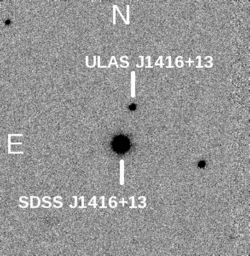
It’s not that often that I can find a reason to write about both astrophysics and music — my obsessions, vocations and avocations — at the same time. But the recent release of Scott Walker‘s (certainly weird, possibly wonderful) new record Bish Bosch has given me just such an excuse: Track 4 is a 21-minute opus of sorts, entitled “SDSS1416+13B (Zercon, A Flagpole Sitter)”. The title seems a random collection of letters, numbers and words, but that’s not what it is: SDSS1416+13B is the (very slightly mangled) identification of an object in the Sloan Digital Sky Survey (SDSS) catalog — 1416+13B means that it is located at Right Ascension 14h16m and Declination 13° (actually, its full name is SDSS J141624.08+134826.7 which gives the location more precisely) and “B” denotes that it’s actually the second of two objects (the other one is unsurprisingly called “A”).
In fact it’s a pretty interesting object: it was actually discovered not by SDSS alone, but by cross-matching with another survey, the UK Infrared Deep Sky Survey (UKIDSS) and looking at the images by eye. It turns out that the two components are a binary system made up of two brown dwarfs — objects that aren’t massive enough to burn hydrogen via nuclear fusion, but are more massive than even the heaviest planets, often big enough to form at the centre of their own stellar systems, and heavy enough have some nuclear reactions in their core. In fact, the UKIDSS survey has been one of the best ways to find such comparatively cool objects; my colleagues Daniel Mortlock and Steve Warren found one of the coolest known brown dwarfs in UKIDSS in 2007, using techniques very similar to those they also used to find the most distant quasar yet known, recounted by Daniel in a guest-post here. Like that object, SDSS1416+13B is one of the coolest such objects ever found.
What does all this have to do with Scott Walker? I have no idea. Since he started singing as a member of the Walker Brothers in the 60s — and even more so since his 70s solo records, Walker has been known for his classical-sounding baritone, though with his mannered, massive vibrato, he always sounds a bit like a rocker’s caricature of a classical singer. I’ve always thought it was more force of personality than actual skill that drew people — especially here in the UK — to him.
His latest, Bish Bosch, the third in a purported trilogy of records he’s made since resurfacing in the mid-1990s, veers between mannered art-songs and rock’n’roll, silences punctuated with electric guitars, fart-sounds and trumpets.
The song “SDSS1416” itself is an (I assume intentionally funny?) screed, alternating sophomoric insults (my favourite is “don’t go to a mind reader, go to a palmist; I know you’ve got a palm”) with recitations of Roman numerals and, finally, the only link to observations of a brown dwarf I can find, “Infrared, infrared/ I could drop/ into the darkness.” Your guess is as good as mine. It’s compelling, but I can’t tell if that’s as an epic or a train wreck.
One response to “SDSS 1416+13B”
Science as metaphor
In further pop-culture crossover news, I was pleased to see this paragraph in John Keane’s review of Alan Ryan’s “On Politics” in this weekend’s Financial Times: Ryan sees this period [the 1940s] as the point of triumph of…